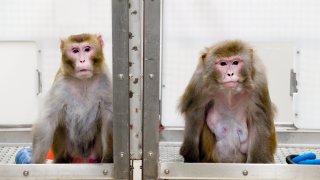
- A 3 minute 27 second YouTube video appears to show the monkey controlling a computer with its brain activity.
- The nine-year-old macaque had two Neuralink devices put on on each side of his brain about six weeks ago.
- The devices are connected to 2,000 tiny wires that observe neural activity in the monkey's brain.
Neuralink, the brain machine interface company founded by Tesla CEO Elon Musk, has published a YouTube video of a macaque monkey called Pager playing the video game Pong with its mind.
The 3 minute 27 second video, shared by Musk on Twitter late Thursday, appears to show the monkey controlling a computer with its brain activity.
"A monkey is literally playing a video game telepathically using a brain chip," Musk wrote on Twitter.
The Hurricane season is on. Our meteorologists are ready. Sign up for the NBC 6 Weather newsletter to get the latest forecast in your inbox.
In the video, a narrator attempts to explain how Pager is able to play Pong with his mind.
The nine-year-old monkey, which had two Neuralink devices put on each side of his brain about six weeks ago, learned how to use a joystick to move a cursor to targets on a screen in exchange for a banana smoothie delivered through a straw, the narrator says.
He goes on to explain that the company's "Link" devices recorded Pager's neuron activity while he interacted with the computer. This was possible due to the more than 2,000 tiny wires implanted in the regions of his motor cortex that co-ordinate hand and arm movements, the narrator said.
This data was then fed into a "decoder algorithm" to predict Pager's intended hand movements in real time.
Money Report
Once the decoder had been calibrated, Neuralink said the monkey was able to use it to move the cursor where he wanted it to go, instead of relying on the joystick.
Indeed, the YouTube video shows Pager controlling a paddle in the arcade game Pong while the joystick is unplugged.
But Andrew Jackson, Professor of Neural Interfaces at Newcastle University, told CNBC that brain-control of computer cursors by monkeys is not new.
"The first comparable demonstrations were published in 2002 although it could be argued the idea dates back to work by Eberhard Fetz in the 1960s," said Jackson, adding that the approach has also been tested in humans since 2006. "The control in the video looks impressive, but without seeing a proper publication on their data it is hard to say how it compares to the current state-of-the-art."
He said what was "definitely new and innovative" was the fact that there are no cables coming through the skin, and that the brain signals were all being sent wirelessly.
"This to me is the advance here, and is important both for improving the safety of human applications (wires through the skin are a potential route for infection) and also as a way of improving the welfare of animals used in neuroscience studies," Jackson said.
Pigs to monkeys
In August, Neuralink conducted a live demo of its technology on three pigs. An audience was shown real-time neural signals from one of the pigs, which Musk named Gertrude.
Headquartered in San Francisco, Neuralink ultimately wants to increase the rate at which information can flow from the human brain to a machine.
While the technology is still in its infancy, Neuralink hopes that its devices will soon allow paralyzed humans to use their minds to operate machines.
On Thursday, Musk said the first Neuralink product will allow a paralyzed human to use a smartphone with their mind faster than someone using their thumbs.
AI is only going to get smarter and Neuralink's technology could one day allow humans to "go along for the ride," Musk said in an interview on Clubhouse in January.
To illustrate the pace of progress in AI, the innovator — who believes that machine intelligence will eventually surpass human intelligence — pointed to breakthroughs made at research labs like OpenAI, which he co-founded, and DeepMind, a London AI lab that was acquired by Google in 2014. DeepMind has "run out of games to win at basically," said Musk, who was an early investor in the company.
People are in effect already "cyborgs" because they have a tertiary "digital layer" thanks to phones, computers and applications, according to Musk.
"With a direct neural interface, we can improve the bandwidth between your cortex and your digital tertiary layer by many orders of magnitude," he said. "I'd say probably at least 1,000, or maybe 10,000, or more."
The digital layer he refers to could be anything from a person's iPhone to their Twitter account.
Long term, Musk claims that Neuralink could allow humans to send concepts to one another using telepathy and exist in a "saved state" after they die that could then be put into a robot or another human. He acknowledged that he was delving into sci-fi territory.






